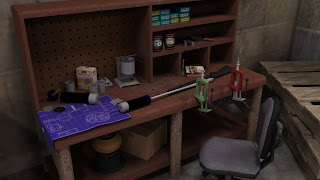 |
| CZ858 and RPG-7 crates |
I am currently working on my demo-reel, and surprise surprise I made it about firearms... unless this is the first time reading something from this blog then it IS a surprise.
The first environment is set in some SHTF-esque safehouse. The inhabitants can only afford surplus or cheap sporting firearms, and they reload their own ammunition (except for the .22 LR because you can't reload rimfire cartridges without VERY special equipment, good thing the bulk ammo is generally inexpensive.)
The above image is just some crates of surplus RPG-7s, CZ 858s, and rockets. The scribbling on the side of the crates state what firearm is in there, both in Russian and Czech. The original idea was to put the rifles in a box with a bunch of shredded paper, and it looked terrible.
 |
| Gun Rack |
 |
| Workbench and makeshift suppressor |
Now attached to the stainless Ruger 10/22 is a suppressor. I did some research on how suppressors worked, and the ways to make one out of pipes and a few extra things. Seeing as this is a safehouse where it's inhabitants do not have immense funding, a makeshift suppressor is more valid than a commercial one.
Keep in mind that these are not the finished product, and I am still working on the texturing, this is more or less an update.
-Mike



